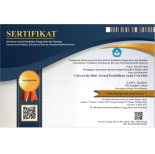TEACHING LITERACY THROUGH PLAY: INDONESIAN EARLY CHILDHOOD TEACHERS PRESPECTIVE
Abstract
Keywords
Full Text:
PDFReferences
Bodrova, E. (2008). Make-believe play versus academic skills: A Vygotskian approach to today’s dilemma of early childhood education. European Early Childhood Education Research Journal, 16(3), 357–369.DC: National Clearinghouse for Bilingual Education Issue Brief
Frost, J. L., Wortham, S., & Reifel, S. (2001). Play and child development. Upper Saddle River, NJ: Prentice-Hall Inc.
Genishi, C. & Haas Dyson, A. (2014). Play as the precursor for literacy development. In L. Brooker, M. Blaise, & S. Edwards (Eds.). The Sage Handbook of Play and Learning in Early Childhood. (228-239). London: Sage
McInnes, K., Howard, J., Crowley, K., & Miles G. (2013). The nature of adult-child interaction in the early years classroom: Implication for children’s perception of play and subsequent learning behaviour. European Early Childhood Education Research Journal, 21(2),268-282
Moller, S. J. (2015). Imagination playfulness and creativity in children’s play with different toy. American journal of plat. 7(3), 322-346
Neuman, S. & Roskos, K. (1992). Literacy objects as cultural tools: Effects on children‟s literacy behaviours in play. Reading Research Quarterly, 27(3), 202-225.
Phelps, P. (2008). A longitudinal study exploring the relationship of representational levels of three aspects of preschool sociodramatic play and early academic skills. Journal of Research in Childhood Education, 23(1), 19-28
Prior, J. &Gerard, M. (2004). Environmental print in the classroom: meaningful connections for learning to read. International Reading Association.
Saracho, O. (2001). Teachers‟ perceptions of their roles in promoting literacy in the context of play in a Spanish speaking kindergarten. International Journal of Early Childhood Education, 33(2), 18-31.
DOI: https://doi.org/10.17509/cd.v12i2.37575
Refbacks
- There are currently no refbacks.
Copyright (c) 2021 UPI kampus cibiru

This work is licensed under a Creative Commons Attribution-ShareAlike 4.0 International License.
Cakrawala Dini: Jurnal Pendidikan Anak Usia Dini
Published in collaboration Program Studi PGPAUD UPI Kampus Cibiru, APG PAUD Indonesia, and PPJ PAUD Indonesia

Cakrawala Dini: Jurnal Pendidikan Anak Usia Dini is licensed under a Creative Commons Attribution-ShareAlike 4.0 International License.
Based on a work at https://ejournal.upi.edu/index.php/cakrawaladini.














